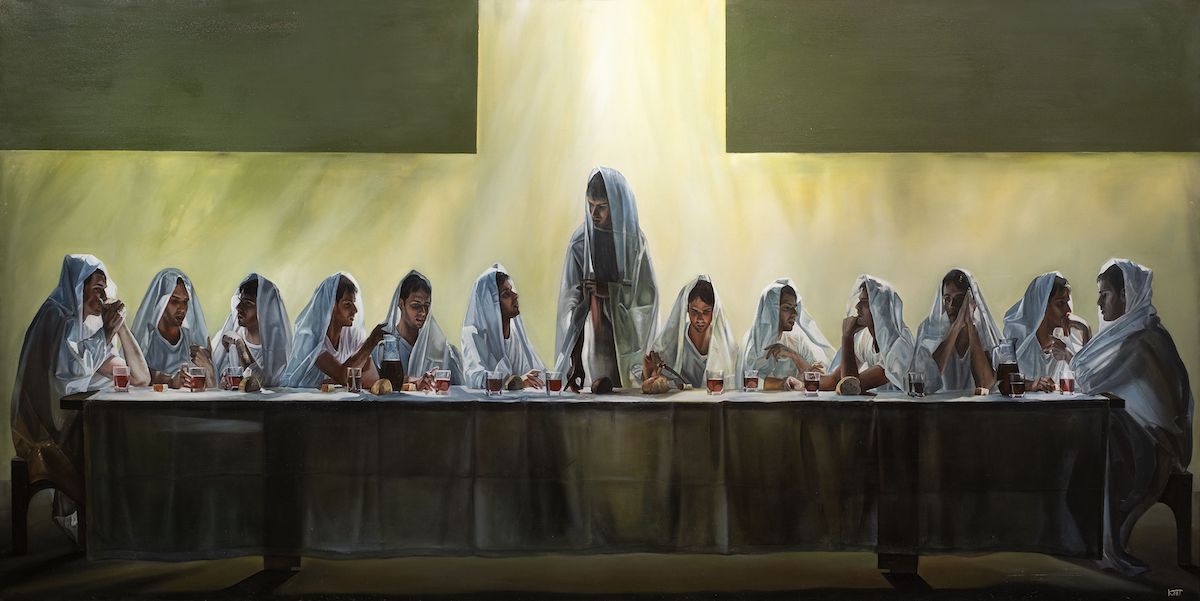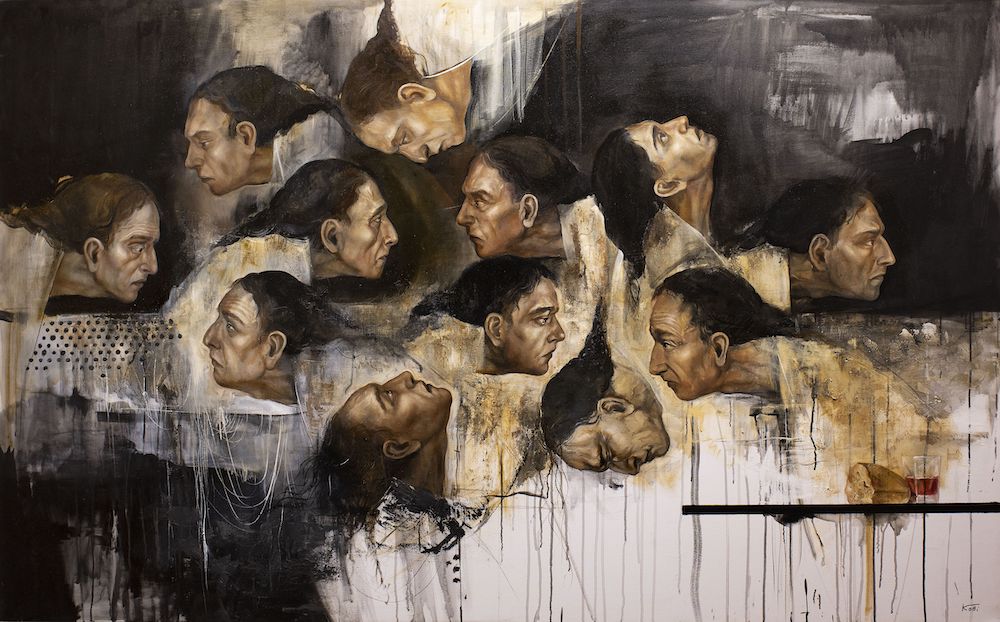
Feel free to add tags, names, dates or anything you are looking for
.jpg)
.jpg)
Recent works of visual art and analytical considerations of them often concentrate on radical changes that point to the future of the art world. The world of art is evolving, and today’s paradigm differs significantly from what was topical even twenty years ago. Consequently, it will become even more disparate in the future. Technology has already altered our lives, transformed art, and pushed the boundaries of imagery. In many situations, the nature of the digital picture, the messages it conveys, and the new vision offered to the eye become the source of inspiration, and it has already become impossible to perceive and comprehend our era and its constituents without it. The Last Supper by Giorgi Kobiashvili is symptomatic of this epoch. In the picture, electronic information in the form of a neon wire, similar to the graphic line of a cardiogram, is directly incorporated into the structure of the composition, and the history of iconography gives way to iconological interpretations. The easily recognizable iconographic model developed by Christian art has been rendered as a mere scheme. The horizontal line of a tablecloth is presented frontally on a virtually empty and monochrome canvas. The monotonous rhythm of the pleated tablecloth, and the symbolic elements of glasses and bread placed on the table at repeated intervals create a concise and distinct image. The QRS wave of the cardiogram in the middle emphasizes the image of Christ, while the other characters from the famous scene are only represented by smaller vertical waves deviating from the graph’s otherwise monotonous line.
.jpg)
Giorgi Kobiashvili. THE LAST SUPPER. 200x110. Oil, mixed media on canvas. 2018. Photo by Gia Chkhatarashvili
The emerging young artist Giorgi Kobiashvili (გიორგი კობიაშვილი) creates paintings that express visions and perceptions of the world, and explorations that are characteristic of the new generation. His paintings depict a dystopian universe that is tense and mysterious, saturated with technologies and apocalyptic themes, and where time and space are conditional. The ‘voice’ of this artist can already be heard in the flow of contemporary Georgian art, and is expressed through an individual experience of relations with the history of painting, free variations of iconographic models, and an increasing energy. Giorgi Kobiashvili’s paintings clearly portray a desire to comprehend the history of painting and the artistic quests of different epochs. The second version of The Last Supper is a figurative composition with surrealistic allusions. The artist appears to be striving to grasp the sense of The Secret Supper through various stylistic experiments.

Giorgi Kobiashvili. THE LAST SUPPER. 300x150. Oil on canvas. 2012. Photo by Gia Chkhatarashvili
His research into both historical and modernist traditions, as well as the canonical and free interpretations of "The Last Supper", served as the foundation for his experimentation. The third version of this theme differs significantly from the two that have already been discussed, and makes use of free montage of the composition in order to produce a cinematic effect. The apostles' reactions and their intense feelings have been captured in emotive portraits; only a small portion of the set table is left visible. All this is lifted from an abstract background of dramatic affect.

Giorgi Kobiashvili. THE LAST SUPPER. 210x130. Acrylic on canvas. 2021. Photo by Gia Chkhatarashvili
The many purposes of the visual language created by Christian culture include education on values and the tremendous experience of searching for transcendental means to communicate ideas and concepts. The history of iconography is still a topic of study and interest, despite the fact that religion no longer plays a significant role in the contemporary world – historical and cultural memories play an active role in contemporary visual thinking. As recent art addresses this phenomenon, questions arise about the significance of accumulated knowledge surrounding the nature of the image and its participation in contemporary human life. In this regard, the motifs found in Giorgi Kobiashvili's artwork are intriguing to contemporary viewers and art historians alike, since they provide a fresh perspective or a new way of looking at an occurrence with which we are apparently already quite familiar. In the versions of The Crucifixion, as well as in the case of Adam and Eve's First Shame, there are references to conventional iconography and modernist patterns, but the artist also offers entirely different, creative choices. It is particularly remarkable to observe iconographic associations in a commonplace item of contemporary life — "human remains" — for which pop-art illustrative style has been carefully selected, and references to examples of symbolic historical painting have been added.
_160x130x3_cm_5000.jpg)
Giorgi Kobiashvili. Adam and Eve's first shame. 160x130x3. 2017.
Giorgi Kobiashvili's paintings display pop art elements, with particular emphasis on the structure of digital images. "3D.XXI Century" is a composition that features computerized visual enhancements and synthetic texture accents applied to a snapshot-style picture of a girl seated on a chair.

Giorgi Kobiashvili. XXI Century. 115x100. Acrylic, oil on canvas. 2021. Photo by Gia Chkhatarashvili
.jpg)
Giorgi Kobiashvili. Amaghleba. 200x150. Oil, canvas. 2018. Photo by Gia Chkhatarashvili
Giorgi Kobiashvili's painting highlights the alienated nature of the electronic world, which is oppressed by nihilism and the threat of dominance by artificial intelligence, and portrays this topical motif of contemporary popular culture as images of the post-apocalyptic world.